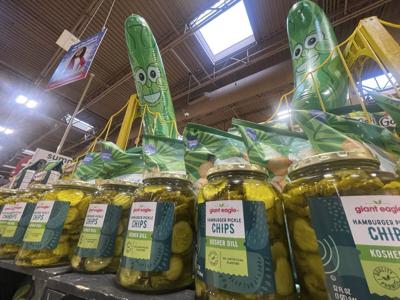SHARPSBURG, Pa. — When did we know for sure?
Was it April, when Nature Made introduced its pickle-flavored gummy vitamins? Was it November, when Petco's "Pickle Mania" promotion offered 26 different pickle-themed toys for dogs and cats?
Maybe it was the December day a food scholar uttered, "Everyone can kind of see their needs met by pickles."
Or perhaps it was just a couple weeks ago, when Instagram chef itsmejuliette (no stranger to online pickle activities) posted a cheeky challenge on her "cooking with no rules" feed: "this is your sign to surprise your neighbor with a pickle wreath." More than 70,000 people liked her post.
People are also reading…
At the intersection of health and edginess, traditionalism and hipsterism, global culture and the American stomach, the pickle in 2024 found itself caught in a mealstrom of words like "viral" and "trending" just as its food-as-fetish-object cousins — bacon and ranch dressing, notably — experienced in years past.
Prepared Foods, an industry newsletter, said it outright in September: "The pickle obsession is at an all-time high."
Cheese & Steak Stuffed Pickles
Tangy Pickle Doritos. Grill Mates Dill Pickle Seasoning for your steak. Portable pouches of pickles. Pickle mayonnaise, pickle hummus, pickle cookies, pickle gummies. Spicy pickle challenges. Pickleback shots at the bar. Pickle juice and Dr. Pepper. Corn puffs colored and flavored like pickles and called, naturally, Pickle Balls.
In Pittsburgh, the cradle of the modern American pickle (talkin' to you, H.J. Heinz), a summer festival called Picklesburgh draws aficionados of the sour and the puckery from several states away for copious amounts of pickle beer washed down by brine, or vice versa.
As 2025 begins, two possible conclusions present themselves. First: The pickle embedded its sour self at the nucleus of the American gastro-zeitgeist for the foreseeable future. Second: This maybe played itself out, and the pickle has jumped the shark.
Still, more of us are living the life of brine.

Pickle products and marketing materials are displayed July 12 at a Giant Eagle market in Glenshaw, Pa.
"I think pickling in general has had a resurgence," says Emily Ruby. She is a curator and expert on the history of the Heinz company for the Heinz History Center in Pittsburgh, a couple miles downriver from this industrial borough where Henry J. Heinz churned out his first packaged pickles in the 19th century. Indeed, pickles are now a $3.1 billion annual market in the United States and growing.
"It's been a scary few years for a lot of people. In 2024 we needed something we could agree on. Maybe it's pickles," says Alex Plakias, an associate professor at Hamilton College in New York who teaches the philosophy of food.
"I was surprised at how the pickle could be all things to all people," says Plakias, whose most recent book is about awkwardness. "All these different food identities in 2024, and no matter who you think of, pickles can be for them."
The American cucumber pickle is crunchy and sour, with an aggressive taste of its own but can accommodate other "flavor profiles" (Ghost pepper pickles! Garlic pickles! Horseradish pickles! Bread and butter chips!).
They're also absurdly low fat — the rare food trend that's not outright bad for you — and some offer the probiotic benefits of fermentation. Key marketing points all.
From a positioning perspective, the pickle exists at the crossroads of homey-slash-traditional (Mom, Lower East Side, preserves, harvests) and edgy-slash-slightly subversive (sour, intense flavors, startup pickle factories in reclaimed industrial neighborhoods).
"It's not like I come from a long line of picklers. But I realized that a cucumber is a blank slate and you get to paint it with all kinds of different brines and spices and salts and sugars," says John Patterson, who founded Pittsburgh Pickle with his brothers out of a church kitchen a decade ago.
"A pickle is something you can rely on and count on," he says. "A pickle is always funny, for some reason. A pickle is never nefarious or mean. It's a peaceful, wholesome business to be in."
Of the cucumber itself, he has this to say: "It's almost like God intended them to be pickled."
The pickle is also, let's be candid, usually green and bumpy and intrinsically unattractive. That means even social-video newbies don't need precision lighting to crank out reasonably compelling pickle content.
Credit — or blame — TikTok for some of the frenzy. Watching the chronicling of pickle-cake baking, pickle-wreath making and pickle-pizza crafting, you get the sense the social platform was made as much for dills as for dancing. Pickle videos there regularly top 2 million viewers, and TikTok recently reported more than 251 million pieces of pickle content.
Then there is the Great Glickle Surge of 2024 — a social media oddity involving someone pouring "edible glitter" into a jar of pickles and making "glickles" — ostensibly a sexier, blingier, even Instagrammier version of pickles.
Finally, COVID-19 likely played a pivotal role. The pandemic's forced inward focus in 2020 and 2021 led many Americans to revisit DIY approaches to food, including baking sourdough bread and, yes, pickling things. It's what Nora Rubel, who researches food and culture, calls "an embrace of 'grandmothercore' culture" by, well, grandchildren.
"Gen Z is taking pickles as their thing. This is the new avocado toast," says Rubel, a professor of Jewish studies at the University of Rochester.
"Pickles are also kind of funny. They're just sort of goofy. You can make a lot of puns about pickles. It's intense flavor, but there's also a kind of silliness about them," Rubel said.
Packaged food is no longer positioned as merely something to eat. It often presents itself as a multimedia experience — something to be talked about and reveled in, to join likeminded communities over, to incorporate into your own personality.
Lifestyle pickles, as it were.
7 key food trends for 2025 forecasted by Instacart purchasing data
7 key food trends for 2025 forecasted by Instacart purchasing data

As 2024 draws to a close and the new year approaches, Instacart shares its anticipated food and grocery trends for 2025. To develop this forecast, Instacart analyzed its purchase data from 2024 to uncover standout insights about how people filled their carts (and kitchens) with items that trended across pop culture and social media over the past year.
The data revealed these key insights:
- Health and wellness are continuing to influence people's grocery purchasing decisions.
- Cooking and baking from scratch is on the rise.
- Enjoying diverse flavors is becoming increasingly important to many.
Here's a deeper dive into the seven top food and grocery trends forecast for 2025.

Prebiotic and Probiotic Power

Digestive health has taken center stage in the wellness conversation, driving a surge of prebiotic and probiotic drink purchases. Prebiotic and probiotic drinks offer a convenient way to support a healthy gut, which is associated with health benefits like improved digestion, enhanced immune function, and mental well-being. This has contributed to a robust year-over-year category growth of 58%, illustrating the substantial consumer demand for gut-friendly options.
In today's fast-paced world, convenience reigns supreme and people are increasingly interested in making small shifts to improve their overall health and wellness, which could be as simple as subbing in a probiotic soda on occasion instead of a "traditional" one. Considering the massive category growth seen this year, it's likely the gut-friendly excitement will continue into the year ahead with even more consumers purchasing prebiotic and probiotic drinks.
Non-Alcoholic Renaissance

The non-alcoholic beverage trend is making a significant splash, reshaping social norms and consumer habits alike. As more individuals seek to enjoy social gatherings without alcohol, alternatives like non-alcoholic beers, wines, and spirits have become more prominent. Instacart data shows that the share of orders containing canned non-alcoholic cocktails (+404%), non-alcoholic spirits (+129%), non-alcoholic wines (+28%), and non-alcoholic beers (+17%) have all increased over the past year.
Younger generations, particularly Gen Z and millennials, are at the forefront of this trend. Known for their health-first mindsets, they are more likely to experiment with non-alcoholic options in social situations and as a way to wind down at the end of the day. It's clear that the stigma around opting out of alcohol is fading, with non-alcoholic beverages providing a bridge that allows everyone to engage in the shared social experience of enjoying a drink.
Protein Powerhouses

A high-protein diet has been celebrated across social media as a key way to lose weight and build muscle, spurring a movement of people looking for ways to boost their protein intake throughout the day. As a result, cottage cheese is re-emerging as a beloved food item with a 17% increase in the share of purchases in 2024, thanks to its protein-rich benefits. Whether churned into ice cream, added to smoothies, or baked into this viral flatbread recipe, cottage cheese has found its way back to people's refrigerators in a big way. In addition, purchases for protein-packed Greek and Icelandic yogurt have also increased by 6%, underscoring the current craze for consuming high-protein foods that have simple, transparent ingredients.
Tinned Fish Frenzy

In 2024, tinned fish made waves across social media and beyond. With an increase in order share for canned mackerel up 74% and sardines climbing 13%, these pantry staples are not just about convenience. Tinned fish platters and inventive recipes have captured the imaginations of Gen Z and millennials, linking seamlessly with the #tomatogirl aesthetic, which celebrates classic and nostalgic foods.
Incorporating tinned fish into meals echoes the rustic simplicity popularized by the #tomatogirl trend, speaking to a growing interest in cooking that's accessible, affordable, and packed with flavor. With consumers increasingly seeking fresh, simple, and wholesome ingredients, the appeal of tinned fish is likely here to stay as a staple for weekly meal planning and special dinners and spreads.
The Hydration Craze

Staying hydrated has always been a cornerstone of healthy living, but getting enough water throughout the day has recently become a hot topic of conversation. The bold 36% increase in order share for electrolyte drink powders in the past year reflects the growing cultural priority placed on optimal hydration. As seen on social media, stainless steel tumblers and water bottles have become the icons of this movement, as younger generations clamor to get the "it" vessel for hydration. This points to hydration being celebrated not just as a necessity, but as a lifestyle.
For health-conscious consumers, hydration content online has shared that drinking more water can not only lead to overall wellbeing, but also aid in more aesthetic perks such as clearer skin and weight loss. It's not just about electrolytes, though—the share of purchases for coconut water have risen by 7% over the past year, indicating there are multiple avenues for staying hydrated.
Baking From Scratch Resurgence

Baking from scratch is back in full swing and ovens are pre-heating everywhere as people rediscover the joy of breadmaking. While sourdough may have seen its heyday in 2020, the love for homemade baked goods shows no signs of waning. Data reveals a 49% increase in the share of bread flour orders, alongside a 17% uptick in wheat berry purchases. These trends reflect a growing social media movement encouraging less processed foods and more baking and cooking from scratch. This revival in breadmaking might be tied to the "homesteader" trend, which has garnered millions of views on social platforms. This lifestyle embraces the self-sufficient, back-to-basics approach of producing your own food and encourages people to find nourishment not just in consuming food, but in the very act of creating it.
Homemade breadmaking isn't the only food trend gaining in popularity: At-home pizza making is also having a moment. The share of orders with 00 flour, renowned for its quality in pizza making, have grown by 45%, while orders containing pizza sauce are also up by 9%.








